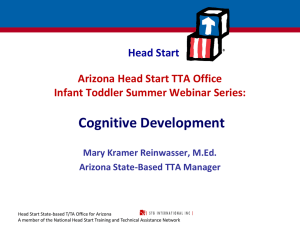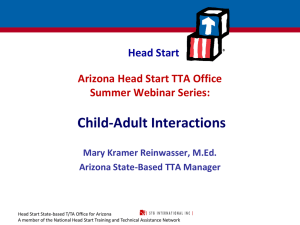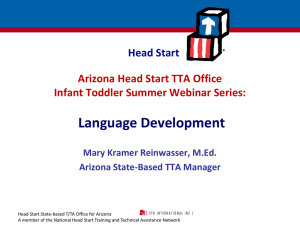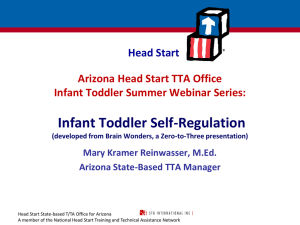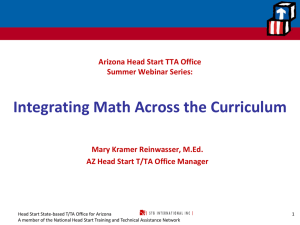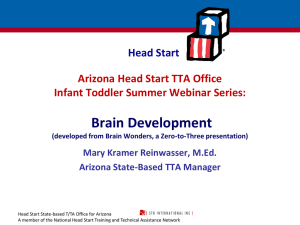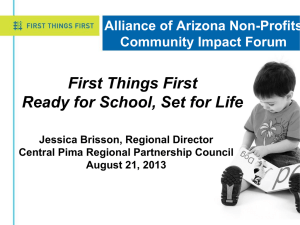Intentional Teaching (2 parts) - Arizona Head Start Association
advertisement
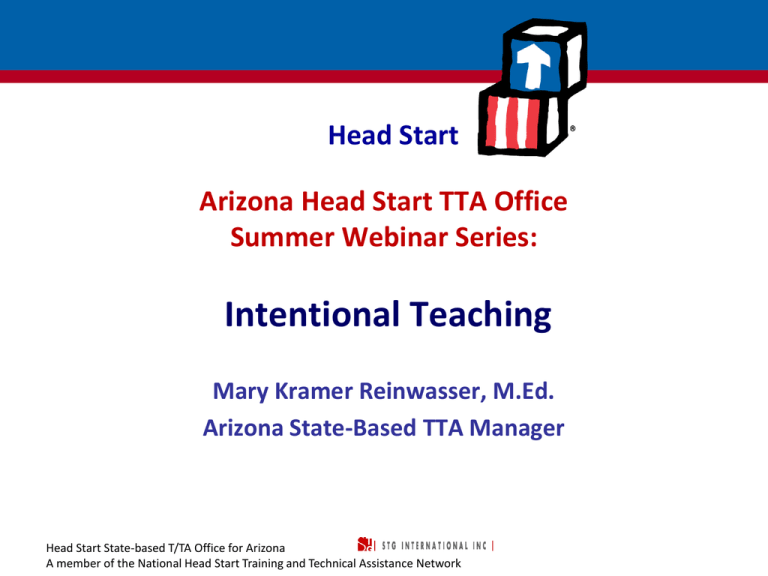
Head Start Arizona Head Start TTA Office Summer Webinar Series: Intentional Teaching Mary Kramer Reinwasser, M.Ed. Arizona State-Based TTA Manager Head Start State-based T/TA Office for Arizona A member of the National Head Start Training and Technical Assistance Network Agenda Part One: • Defining intentional teaching and intentional curriculum • Principles of intentional teaching and intentional curriculum • Intentional Teaching strategies: – Principles of effective teaching strategies – Child-guided versus adultguided – Differentiated teaching – Multisensory approach Part Two: (strategies continued) • Language Development – Conversations – Open-ended questions – Vocabulary Development • Approaches to learning – Initiative and curiosity – Engagement and persistence – Reasoning and problem solving • Continuum of Teaching Behaviors • Guidelines for Teaching Teams Head Start State-based T/TA Office for Arizona A member of the National Head Start Training and Technical Assistance Network 2 Learning Outcomes 1. Participants will be able to define intentional teaching 2. Participants will be able to name the principles of intentional teaching 3. Participants will be able to identify strategies for language development and approaches to learning 4. Participants will be able to describe the continuum of teaching behaviors Head Start State-based T/TA Office for Arizona A member of the National Head Start Training and Technical Assistance Network 3 Why intentionality? • The gap in achievement between low-income children and their middleclass peers is real and significant. • Using an intentional curriculum is an important strategy to reduce the achievement gap, and since no curriculum is teacher-proof, strategies to help teachers effectively use the curriculum are equally important. • Low-income children make gains in early literacy and early math when high-quality preschool programs include an intentional curriculum • An intentional curriculum is research-based, emphasizes teachers actively engaged with children, includes attention to social and regulatory skills, is responsive to cultural diversity and English language learners, is not teacher-proof, and requires new ways to measure classroom quality, teacher effectiveness, and student progress. Head Start State-based T/TA Office for Arizona A member of the National Head Start Training and Technical Assistance Network 4 What is intentional teaching? Intentional teaching is “to always be thinking about what we are doing and how it will foster children’s development and produce real and lasting learning.” (Epstein, 2007, p.10) “In everything teachers plan and do in the Head Start education program, they need to be highly intentional. That is, they need to work with the outcomes for children in mind and consciously seek out every opportunity to help children achieve these outcomes through the learning experiences they plan, the ways they interact with children, and the ways they create and regularly modify the environment.” From "Seeing the Big Picture in Head Start." Head Start Leaders Guide to Positive Child Outcomes. HHS/ACF/ACYF/HSB. 2003. English. Head Start State-based T/TA Office for Arizona A member of the National Head Start Training and Technical Assistance Network 5 What is an intentional teacher? The one attribute that seems to be characteristic of outstanding teachers is intentionality, doing things on purpose. (Slavin, 2000, p. 7) • What am I trying to accomplish? • What are my students' relevant experiences and needs? • What approaches and materials are available to help me challenge every student? • How will I know whether and when to change my strategy or modify my instruction? • What information will I accept as evidence that my students and I are experiencing success? Head Start State-based T/TA Office for Arizona A member of the National Head Start Training and Technical Assistance Network 6 What is an intentional curriculum? • • • • • An intentional curriculum is a research-based curriculum that includes “planned, organized, sequenced activities and lessons focusing on academic readiness”. (p.7) The curriculum is age-appropriate and fun for young children. It emphasizes active engagement of teachers and children, Addresses social and adaptive skill development, Is culturally sensitive, and Contains a process to rate – classroom quality, – teacher effectiveness, and – student progress. Head Start State-based T/TA Office for Arizona A member of the National Head Start Training and Technical Assistance Network 7 Joint Position Statement on Curriculum Policymakers, the early childhood profession, and other stakeholders in young children’s lives have a shared responsibility to implement a curriculum that is: • Thoughtfully planned • Challenging • Engaging • Developmentally appropriate • Culturally and linguistically responsive • Comprehensive across all developmental domains • Likely to promote positive outcomes for all young children Source: National Association for the Education of Young Children (NAEYC) and National Association of Early Childhood Specialists in State Departments of Education (NAECS/SDE) (2003). Early childhood curriculum, assessment, and program evaluation: Building an effective, accountable system in programs for children birth through age 8. Washington, DC: NAEYC < www.naeyc.org/about/positions/pdf/CAPEexpand. Head Start State-based T/TA Office for Arizona A member of the National Head Start Training and Technical Assistance Network 8 Principles of an Intentional Curriculum Plan the Curriculum • Ensure a research-based developmentally–appropriate curriculum is in place • Provide daily opportunities for children to choose their play activities indoors and outdoors • Take dictations from children frequently and post them in locations visible to children and families • Equip centers with various writing materials in order to encourage children create print during play • Use questions that encourage children to think and reason, and also use expanded language Head Start State-based T/TA Office for Arizona A member of the National Head Start Training and Technical Assistance Network 9 Principles of an Intentional Curriculum Structure the physical learning environment • Ensure both indoor and outdoor environments are safe for children • Use interest areas or centers to organize the classroom space. Have plenty of different types of equipment and materials • Display what children have created and topics in which they are interested. Good physical learning environments will have the following: – Child-sized furniture – Materials that are labeled and on open shelves – Quiet and active centers Head Start State-based T/TA Office for Arizona A member of the National Head Start Training and Technical Assistance Network 10 Principles of an Intentional Curriculum Schedule the program day • Have a consistent, yet flexible daily routine and include a variety of types of activities • Use a variety of groupings, including opportunities for children to work alone or with another child • Use lesson plans that reflect activities consistent with the curriculum • Provide a variety of activities within recurrent routines that provide structure for the children’s day • Post a picture schedule at the child’s eye level to reflect child initiated play, small group and whole group instructional time, and refer to it throughout the day Head Start State-based T/TA Office for Arizona A member of the National Head Start Training and Technical Assistance Network 11 Principles of an Intentional Curriculum Interact with children • Connect with children and build relationships with them • Help children feel secure by providing a warm and caring environment • Encourage and support language and communication • Encourage initiative in children by respecting their choices and interests and welcoming their ideas • Acknowledge children’s activities and accomplishments through praise and encouragement • Support peer interactions by modeling reciprocal relationships with the children • Encourage independent problem-solving Head Start State-based T/TA Office for Arizona A member of the National Head Start Training and Technical Assistance Network 12 Principles of an Intentional Curriculum Build relationships with families • Exchange information with families about the curriculum and how it promotes children’s development • Provide information and strategies to families about how to extend learning at home • Explain activities to family members and encourage them to participate, according to school rules, in the classroom, outdoors, and in other class activities and events • Encourage family members to share cultural heritage and practices, stories, activities and languages • Examples of ways families can extend learning at home through naturally occurring learning experiences Head Start State-based T/TA Office for Arizona A member of the National Head Start Training and Technical Assistance Network 13 Principles of an Intentional Curriculum Assess children’s development • Use assessment results and on-going progress monitoring to plan for individual children and for the whole group • Observe children to obtain information on how they learn, interact with others, engage with new materials, expand ideas, etc. • Assess mastery of a skill as well as the ability of the child to demonstrate the skill across other settings and with other people • When necessary, realign expected outcomes based on ongoing monitoring of progress Head Start State-based T/TA Office for Arizona A member of the National Head Start Training and Technical Assistance Network 14 Intentional Teaching Strategies Head Start State-based T/TA Office for Arizona A member of the National Head Start Training and Technical Assistance Network 15 Key Principles about Effective Early Learning Strategies 1. High quality, continuous early care and education helps lowincome children do better in school. 2. Social-emotional development is the foundation for, and intertwined with, early cognitive development. 3. Formal early learning occurs in a variety of settings, including school-based, center-based, and home-based programs, so it is important to pay attention to all settings when considering strategies to improve achievement and close the gap. 4. Closing or reducing the achievement gap is not simple and requires a comprehensive approach that goes beyond only efforts to improve what children know and can do and must consider how families, schools, and communities can support early learning and the transition to school. Head Start State-based T/TA Office for Arizona A member of the National Head Start Training and Technical Assistance Network 16 Child-guided versus adult-guided experiences • Child-guided: refers to experience that proceeds primarily along the lines of children’s interest and actions, although teachers often provide the materials and other support. • Adult-guided: refers to experience that proceeds primarily along the lines of the teacher’s goals, although that experience may also be shaped by children’s active engagement (Epstein, 2007, p. vii). Head Start State-based T/TA Office for Arizona A member of the National Head Start Training and Technical Assistance Network 17 Differentiated teaching • Provide a focus to hold children’s attention • Break teaching into small parts • Provide hands-on practice • Use an integrated approach. Head Start State-based T/TA Office for Arizona A member of the National Head Start Training and Technical Assistance Network 18 Multisensory practices make sense • • • • Use real materials Use chants and rhymes. Make it fun! Provide natural environments Head Start State-based T/TA Office for Arizona A member of the National Head Start Training and Technical Assistance Network 19 Making sense and meaning are essential • • • • Tap into prior knowledge Use organizers. Provide hands-on practice Give the children time to reflect Head Start State-based T/TA Office for Arizona A member of the National Head Start Training and Technical Assistance Network 20 Questions Head Start State-based T/TA Office for Arizona A member of the National Head Start Training and Technical Assistance Network 21 The Arizona Head Start Training and Technical Assistance Office and STG International thank you for joining our webinar today! Please continue to join the 2010 Summer Webinar Series occurring every Tuesday and Thursday during the months of June and July at 3:00 Pacific Daylight Time. Please contact Mary Kramer Reinwasser at mary.reinwasser@stginternational.com for more information. Head Start State-based T/TA Office for Arizona A member of the National Head Start Training and Technical Assistance Network 22 Intentional Teaching: Part Two Head Start State-based T/TA Office for Arizona A member of the National Head Start Training and Technical Assistance Network 23 Agenda – Part Two Part One: • Defining intentional teaching and intentional curriculum • Principles of intentional teaching and intentional curriculum • Intentional Teaching strategies: – Principles of effective teaching strategies – Child-guided versus adultguided – Differentiated teaching – Multisensory approach Part Two: (strategies continued) • Language Development – Conversations – Open-ended questions – Vocabulary Development • Approaches to learning – Initiative and curiosity – Engagement and persistence – Reasoning and problem solving • Continuum of Teaching Behaviors • Guidelines for Teaching Teams Head Start State-based T/TA Office for Arizona A member of the National Head Start Training and Technical Assistance Network 24 Learning Outcomes 1. Participants will be able to define intentional teaching 2. Participants will be able to name the principles of intentional teaching 3. Participants will be able to identify strategies for language development and approaches to learning 4. Participants will be able to describe the continuum of teaching behaviors Head Start State-based T/TA Office for Arizona A member of the National Head Start Training and Technical Assistance Network 25 Language Modeling Head Start State-based T/TA Office for Arizona A member of the National Head Start Training and Technical Assistance Network 26 Language Modeling • Conversations • Open-ended questions • Vocabulary development Head Start State-based T/TA Office for Arizona A member of the National Head Start Training and Technical Assistance Network Conversation: Respectful Listening How do we show respect for the other person in a conversation? – By giving people time to form thoughts, to respond, and to complete their statements – By focusing on the concern that the other person is expressing. – By letting the other person begin the conversation or do a lot of the talking. From the ECLKC on Speaking and Listening Respectively Head Start State-based T/TA Office for Arizona A member of the National Head Start Training and Technical Assistance Network Conversation: Respectful Listening How do we help keep a conversation open an moving forward? – Door Openers ("Would you like to talk?) – Encourages ("I'd like to hear more about what you think" or "I'm here if you want to talk over your ideas") – Open Questions ("What are some of your ideas?“) – Nodding, saying "yes" or "no" or "I hear you" or "uh-huh" or "tell me more“ – Facial and body expressions that show interest From the ECLKC on Speaking and Listening Respectively Head Start State-based T/TA Office for Arizona A member of the National Head Start Training and Technical Assistance Network Conversation: Respectful Listening What should we avoid doing so that we don't block the progress of a conversation? – – – Saying “always” or “never” Lecturing Facial or body expression that shows a lack of interest From the ECLKC on Speaking and Listening Respectively Head Start State-based T/TA Office for Arizona A member of the National Head Start Training and Technical Assistance Network Open-ended Questions • Open-ended questions don’t have right and wrong answers. • Open-ended questions encourage children to recall what they’ve done and to practice talking about it. • Open-ended questions can produce more than one kind of response. • Open-ended questions are appropriate almost any time during almost any activity. • Open-ended questions can be used to help teach children to solve problems. • Asking open-ended questions can stimulate children to use more specific vocabulary to explain what they’re doing. Head Start State-based T/TA Office for Arizona A member of the National Head Start Training and Technical Assistance Network Vocabulary Development To enhance children’s ability to communicate and to use an increasingly complex and varied vocabulary… • Respond to children's speech with expansions and questions that point out causes and consequences. • Introduce new words and using new words • Talk about a book you are going to read to children before reading it, asking them to predict from the title or cover what the story will be about or what might happen next. • Talk with children after reading a story; ask them to retell the story or act it out. Encourage them to talk about the characters and events, answering their questions and responding to their comments. Head Start State-based T/TA Office for Arizona A member of the National Head Start Training and Technical Assistance Network Vocabulary Development To enhance children’s ability to communicate and to use an increasingly complex and varied vocabulary… • Write down children's messages to parents or others, dictations for language experience charts, or stories, and read them back. • Participate in play to get it going if children have difficulty or to extend it to include more language interaction. • Get in the habit of giving children plenty of time—five seconds or so—to respond to a question or conversational comment. • Plan in-depth projects with children to investigate questions or topics of interest that expand vocabulary and provide opportunities for extended discussion and different points of view. Head Start State-based T/TA Office for Arizona A member of the National Head Start Training and Technical Assistance Network Approaches to Learning The following is an excerpt from the Head Start Leaders Guide to Positive Child Outcomes. Domain 7: Approaches to Learning www.eclkc.gov Head Start State-based T/TA Office for Arizona A member of the National Head Start Training and Technical Assistance Network 34 Initiative and Curiosity Strategies • Encourage children's natural inclination to ask questions and to wonder. Help them refine their questions and think of ways they might get answers. • Provide meaningful, realistic choices of play and work experiences. • Help children who have difficulty making choices by limiting choices or helping them think through their options. • Engage children in science and math experiences that start with asking questions, forming hypotheses or making guesses, collecting data, and drawing conclusions. • Read or write stories in which children change or make up their own endings. Head Start State-based T/TA Office for Arizona A member of the National Head Start Training and Technical Assistance Network Initiative and Curiosity • Play games that build on and extend children's curiosity, such as, "I Spy" or "Mystery Bag." • Be flexible enough to change plans if children initiate a more interesting idea or experience. Head Start State-based T/TA Office for Arizona A member of the National Head Start Training and Technical Assistance Network 36 Engagement & Persistence Strategies • Play games in which children must listen carefully and follow more than one direction, such as "Simon says, stand on one foot and touch your nose." • Assign children important, necessary tasks that involve following multiple-step directions: "Take your coat off, hang it in the cubby, and pick out a book to enjoy." • When children quit or give up too easily, gently encourage them by saying, "Try one more time" or "Think of something else you could try." • Gradually lengthen the time children are expected to remain engaged in activities or experiences; for instance, read longer stories to extend children's attention span. Head Start State-based T/TA Office for Arizona A member of the National Head Start Training and Technical Assistance Network 37 Engagement & Persistence Strategies • Engage children in prior planning of their own and remind them of their plans as needed: "What was it you planned to do today? Are you finished?" • Provide ways for children to revisit and reflect on their experiences and learning. • Make frequent comments about children's efforts: "Look how hard you've been trying to put that puzzle together. You're almost finished." • Help children identify successful strategies for problem-solving: "It really helps when you look for the very first letter of your name to find your cubby." • Offer praise that is specific and meaningful to what a child (or children) have actually done Head Start State-based T/TA Office for Arizona A member of the National Head Start Training and Technical Assistance Network 38 Reasoning & Problem Solving Strategies • Engage children in generating multiple solutions to questions or problems: "It is raining and we can’t go outside. What could we do instead?" • When exploring or experimenting with a science or math topic, engage children in the scientific method of asking questions, generating hypotheses, gathering data, predicting what will happen, and observing consequences. • Play games that involve classifying, comparing, and contrasting, such as Dominoes, Lotto, and other matching and sorting games. • Ask children to classify objects using more than one attribute ("Find the large, blue square; find the small, red circle."). Head Start State-based T/TA Office for Arizona A member of the National Head Start Training and Technical Assistance Network 39 Reasoning & Problem Solving Strategies • Help children verbalize their reasoning, thinking out loud about how to solve a problem or answer a question. Write down children's recommended ways of solving problems as well as their solutions to problems. Try them out. • Model open-mindedness and creativity. Demonstrate that there may be more than one way to do things or to solve problems. • Encourage children to think of as many solutions as they can to interpersonal problem situations. Ask them to think about what would happen next if they use a certain solution or to anticipate the consequences of an action. • Read and act out stories in which characters reason and solve challenging problems. Head Start State-based T/TA Office for Arizona A member of the National Head Start Training and Technical Assistance Network 40 Continuum of Teaching Behaviors Head Start State-based T/TA Office for Arizona A member of the National Head Start Training and Technical Assistance Network 41 Nondirective Teaching Behaviors CONTINUUM OF TEACHING BEHAVIORS (Based on Bredekamp and Rosegrant, 1992) Nondirective Ackno Give attention and positive encouragement to keep a child wledge engaged in an activity. Model Display for children a skill or desirable way of behaving in the classroom, through actions only or with cues, prompts, or other forms of coaching. Head Start State-based T/TA Office for Arizona A member of the National Head Start Training and Technical Assistance Network From the ECLKC on Seeing the Big Picture in Head Start Mediating Teacher Behaviors Mediating Facilitate Offer short-term assistance to help a child practice in developing a skill (as an adult does in holding the back of a bicycle while a child pedals). Support Provide a fixed form of assistance, such as displaying the alphabet near a writing center for children to refer to. Scaffold Support children to work "on the edge" of their current competence; set up challenges or assist Head Start State-based T/TA Office for Arizona A member of the National Head Start Training and Technical Assistance Network 43 Directive Teaching Behaviors Directive Co-construct learn or work collaboratively with children on a problem or task, such as building a model or block structure. Demonstrate Actively display a behavior or engage in an activity while children observe the outcome. Direct Provide specific directions or instructions for children's behavior within narrowly defined dimensions of error. Head Start State-based T/TA Office for Arizona A member of the National Head Start Training and Technical Assistance Network 44 Guidelines for Teaching Teams • Use the child outcomes framework and a well-designed curriculum to plan and individualize in all domains. • Be planful and intentional in interacting with children and creating learning experiences to achieve desired child outcomes • Pay attention to what children need to know and be able to do to succeed in school • Regularly engage children in focused, small-group experiences to promote thinking processes and concept learning • Reflect on the teacher's role Head Start State-based T/TA Office for Arizona A member of the National Head Start Training and Technical Assistance Network 45 In summary… Ask yourself these reflective questions… • How often are my interactions with children over the day intentional? • How do I demonstrate, through my informal experiences and settings, that I am intentional in my teaching and in the children’s learning? • What does intentional teaching look like in a home-based setting or center-based setting? • Would parents be able to notice that I am intentional in my work with their children? Head Start State-based T/TA Office for Arizona A member of the National Head Start Training and Technical Assistance Network 46 Questions Head Start State-based T/TA Office for Arizona A member of the National Head Start Training and Technical Assistance Network 47 The Arizona Head Start Training and Technical Assistance Office and STG International thank you for joining our webinar today! Please continue to join the 2010 Summer Webinar Series occurring every Tuesday and Thursday during the months of June and July at 3:00 Pacific Daylight Time. Please contact Mary Kramer Reinwasser at mary.reinwasser@stginternational.com for more information. Head Start State-based T/TA Office for Arizona A member of the National Head Start Training and Technical Assistance Network 48

